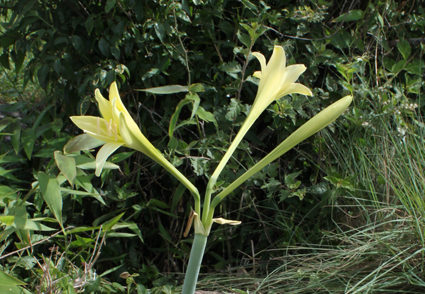Abstract
As part of a series of taxonomic and floristic studies of the endemic vascular flora from Corrientes-Argentina, here we focus our attention on the genus Hippeastrum (Amaryllidaceae). Two species Hippeastrum angustifolium Pax, and Hippeastrum striatum (Lam.) H.E. Moore are cited for Corrientes, Argentina. However, another related taxon, Amaryllis euryphylla Ravenna, a microendemic species from Paraje Tres Cerros, is also recognized for the province. After a detailed study of all original available material, numerous herbarium specimens, and new field collections, we perform a new combination of Amaryllis euryphylla under the genus Hippeastrum as H. euryphyllum. In addition, photographs in its habitat, comments on the geographic distribution and identification key for Hippeastrum species from Corrientes are provided.
References
- Cajade, R., Etchepare, E.G., Falcione, C., Barrasso, D.A. & Álvarez, B.B. (2013) A new species of Homonota (Reptilia: Squamata: Gekkota: Phyllodactylidae) endemic to the hills of Paraje Tres Cerros, Corrientes Province, Argentina. Zootaxa 3709 (2): 162–176. https://doi.org/10.11646/zootaxa.3709.2.4
- Courtis, A., Cajade, R., Piñeiro, J., Hernando, A., Santoro, S. & Marangoni, F. (2022) Population ecology of a critically endangered gecko, endemic to north-eastern of Argentina. Anais da Academia Brasileira de Ciências 94 (4): e20200388. https://doi.org/10.1590/0001-3765202220200388
- Dutilh, J.H.A., Campos-Rocha, A., Oliveira, R.S., Garcia, N., Streher, N.S., Semir, J., Meerow, A.W., Giussani, L.M. & Sassone, A.B. (2020) Hippeastrum, in Flora e Funga do Brasil. Jardim Botânico do Rio de Janeiro. Available from: https://floradobrasil.jbrj.gov.br/FB4354 (accessed 23 May 2023)
- Flora Argentina (2023) Flora Argentina: Plantas Vasculares de la República Argentina (www.http://buscador.floraargentina.edu.ar/) Available from: http://www. Floraargentina.edu.ar (accessed 23 May 2023)
- García, N., Meerow, A.W., Arroyo-Leuenberger, S., Oliveira, R.S., Dutilh, J.H., Soltis, P.S. & Judd, W.S. (2019) Generic classification of Amaryllidaceae tribe Hippeastreae. Taxon 68: 481–498. https://doi.org/10.1002/tax.12062
- Herbert, W. (1821) An Appendix: [General index to the Botanical magazine, vol. 43–48 containing a treatise on bulbous roots]. James Ridgway & Sons, London, 52 pp.
- Hunziker, A.T. (1967). Estudios sobre Amaryllidaceae II. Notas taxonómicas sobre los géneros Hieronymiella, Hippeastrum y Habranthus. Kurtziana 4: 7–18.
- Hunziker, A.T. & Cocucci, A.E. (1959) Estudios sobre Amaryllidaceae. I. Una nueva especie de Hippeastrum del centro de Argentina: H. parodii nov. sp. Boletín de la Academia Nacional de Ciencias, Córdoba, Argentina 41 (1): 5–16.
- QGIS Development Teams (2018) QGIS Geographic Information System. Ver. 3.10. Open Source Geospatial Foundation.
- L’Héritier de Brutelle, C.L. (1788) Sertum Anglicum: seu Plantae Rariores quae in Hortis juxta Londinum, Imprimis in Horto Regio Kewensi Excoluntur, ab Anno 1786 ad Annuum 1787 Observatae. Petri Francisci Didot, Paris, 34 pp. https://doi.org/10.5962/bhl.title.11440
- Lamarck, J. (1783) Encyclopedie Methodique. Botanique 1: 125.
- Meerow, A.W. (2003) Amaryllidaceae. In: Hammel, B.E., Grayum, M.H., Herrera, C. & Zamora, N. (Eds.) Manual de plantas de Costa Rica, vol. 2, Gimnospermas y monocotiledóneas (Agavaceae—Musaceae). Monographs in Systematic Botany from the Missouri Botanical Garden 92. St. Louis: Missouri Botanical Garden Press, pp. 51–55.
- Meerow, A.W. & Snijman, D.A. (1998) Amaryllidaceae. In: Kubitzki, K. (Ed.) The families and genera of vascular plants. vol III. Flowering Plants, Monocotyledons Lilianae (except Orchidaceae). Springer, Berlin, pp. 83–110. https://doi.org/10.1007/978-3-662-03533-7_11
- Moore, H.E. (1963) Amaryllis and Hippeastrum. Baileya 11 (1): 15–16.
- Oliveira, S.R., Semir, J. & Dutilh, J.H.A. (2013) Four new endemic species of Hippeastrum (Amaryllidaceae) from Serra da Canastra, Minas Gerais State, Brazil. Phytotaxa 145 (1): 38–46. https://doi.org/10.11646/phytotaxa.145.1.4
- Oliveira, S.R., Urdampilleta, J.D. & Dutilh, J.H.A. (2017) A new Hippeastrum (Amaryllidaceae) species from Brazil. Phytotaxa 307 (2): 147–152. https://doi.org/10.11646/phytotaxa.307.2.6
- Pax, F.A. (1889) Beiträge zur Kenntnis der Amaryllidaceae. Botanische Jahrbücher für Systematik, Pflanzengeschichte und Pflanzengeographie 11: 318–338.
- Ravenna, P. (2003) Decisive proof on the validity of Amaryllis over Hippeastrum as mainly a south American genus, including new species and new records of Amaryllidaceae from Argentina, Brazil and Paraguay. Onira Botanical Leasflets 9 (2): 9–21.
- Stearn, W.T. (1986) Botanical Latin. Ed. 3. David and Charles Publishers plc, London, 289 pp.
- Slanis, A.C., Huaylla, H., Ortiz, J.E., Luna, L.C. & Feresin, G.E. (2022) Hippeastrum escoipense (Amaryllidaceae, Amaryllidoideae): una nueva especie críptica del noroeste de Argentina. Darwiniana, Nueva Serie 10 (2): 486–493. https://doi.org/10.14522/Darwiniana.2022.102.1066
- Sprengel, K. (1815) Plantarum Minus Cognitarum Pugillus 2. Kümmelium, 98 pp.
- Thiers, B. (2022) [continuously actualized] Index Herbariorum: a global directory of public herbaria and associated staff. New York Botanical Garden’s Virtual Herbarium. Available from: http://sweetgum.nybg.org/ih (accessed 31 January 2022)
- Turland, N.J., Wiersema, J.H., Barrie, F.R., Greuter, W., Hawksworth, D.L., Herendeen, P.S., Knapp, S., Kusber, W.H., Li, D.Z., Marhold, K., May, T.W., McNeill, J., Monro, A.M., Prado, J., Price, M.J. & Smith, G.F. (Eds.) (2018) International Code of Nomenclature for algae, fungi, and plants (Shenzhen Code) adopted by the Nineteenth International Botanical Congress Shenzhen, China, July 2017. Regnum Vegetabile 159. Glashütten: Koeltz Botanical Books. https://doi.org/10.12705/Code.2018


